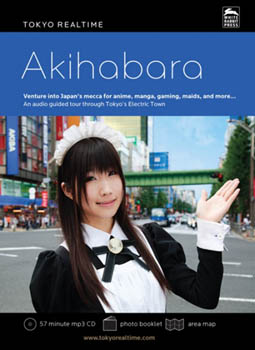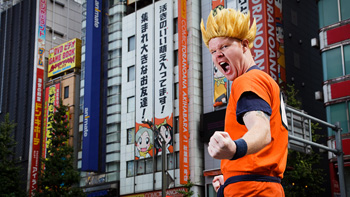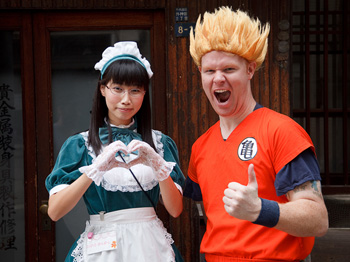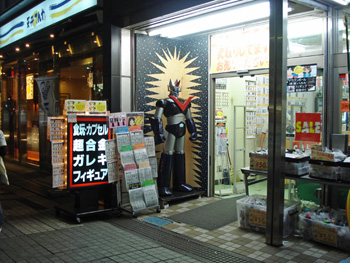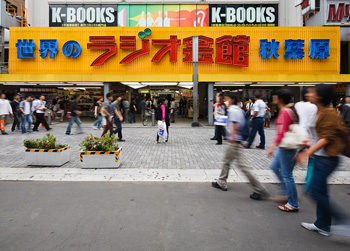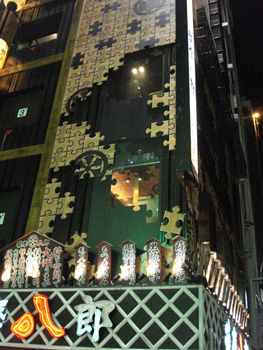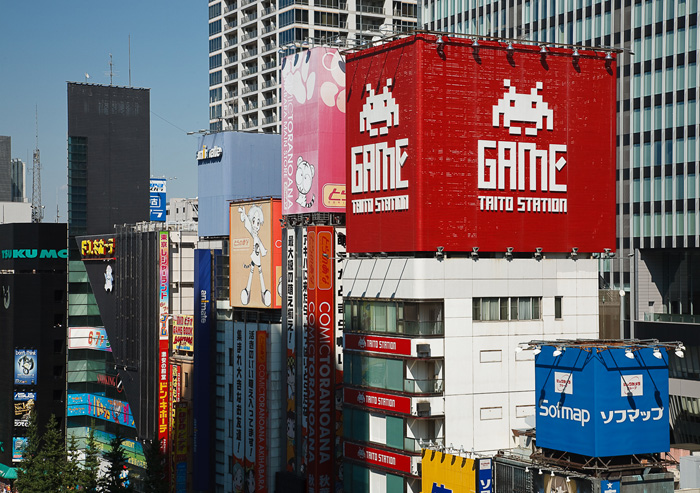New Audio CD Acts as Your Guide to Akihabara Source: White Rabbit Press press release Official Website: www.TokyoRealtime.com
White Rabbit Press is proud to release the world’s first professionally produced audio guided walking tour for Tokyo’s Akihabara district. With TOKYO REALTIME: Akihabara, visitors and residents alike can experience a unique behind-the-scenes tour of Tokyo’s ‘Electric Town’, a subculture hotspot for anime, games, manga, maids and more. Assisted by his sentient GPS ‘Navi’, Akihabara expert Patrick W. Galbraith, author of The Otaku Encyclopedia, guides visitors through all the must-see places. Patrick provides historical background and cultural insight along the way, as well as breaking down insider jargon such as otagei, moé and itasha. The release of TOKYO REALTIME: Akihabara marks the second volume in the highly-acclaimed Tokyo Realtime audio tour series. Interweaving narration and interviews within a soundscape of location ambience and music, Tokyo Realtime audio travel guides deliver a seamless mix of adventure and cultural insight while navigating real-world spaces. “Producer Max Hodges has assembled a crack team of über-geeks from Japan and abroad to navigate Akihabara’s alleys and decode its mysteries. The audio guide is an illuminating portal into the neighborhood’s colorful history and vibrant currents of contemporary pizzaz.” - Roland Kelts, author of Japanamerica.
This Akihabara audio tour features guest commentaries by: Patrick Macias, author of Cruising the Anime City & editor of Otaku USA Magazine Danny Choo, pop-culture blogger & Tokyo Stormtrooper Kaichiro Morikawa, Meiji University professor & author of Learning from Akihabara and others This 57-minute tour, available from White Rabbit Press, includes a CD with mp3 audio, an area map (printed on durable, waterproof paper) and a 20-page full-color booklet of area photography. Listeners simply transfer the audio program to their iPod, iPhone or any other portable mp3 player, go to the starting point shown on the included map and press play. TOKYO REALTIME: Akihabara represents the second volume in the Tokyo Realtime series which launched with an audio tour for the Kabukicho district, Japan’s most imaginative entertainment zone. Each expert guided tour is brought to life through music, sound effects, location ambience and guest commentary from local personalities.
Interview with Patrick W. Galbraith, author and narrator of Tokyo Realtime: Akihabara
Patrick W. Galbraith is a Ph.D. candidate in the Graduate School of Interdisciplinary Information Studies at the University of Tokyo. In 2009, he authored The Otaku Encyclopedia: An Insider’s Guide to the Subculture of Cool Japan. He also writes on Japanese popular culture for various websites, magazines and academic journals.
What first triggered your interest in Japanese popular culture? I met a young girl named Nausicaä, the creation of celebrated anime director Miyazaki Hayao. It was destiny, fate, love at first sight. Seriously, the girl ruined me for real women, and I was only in grade school. I’m from Alaska, and there isn’t much to do there except for drink liberally, engage in sporting activity or stay at home. I was too young to drink and too meek for sports, so I ended up spending a lot of time at home. My older brother was learning Japanese and was into anime, so we watched VHS tapes of whatever he could find. Being in Japanese and with often sketchy subtitles, it was way beyond my ability to comprehend. So I did what any young lad would – I looked at the pretty pictures of beautiful girls. I was 12 when my family moved to Montana, and had trouble adjusting to the new environment and retreated into my room and my anime. My passion for it accelerated until a point when there was no stopping or going back. When I started tattooing my two-dimensional wives onto my body, I knew my life was over. I was reborn as something else, as an “otaku,” an obsessive hobbyist. This love, or perhaps lust, for anime brought me to Japan. I wanted to learn everything I could about the country, people and pop-culture that had such a huge impact on my life. How did you come to be an expert on Akihabara? Akihabara was the first place I visited when I came to Japan as a student in 2004. The city was colorful, vibrant and full of people who loved anime – everything Montana was not! I fell in love with the place, the same way I’d fallen in love with Nausicaä, that one love that ruins you for life. I felt I found myself there among the stacks of manga and toys, reflected on the screens playing sample anime and demos from dating simulator games, shoulder to shoulder with other young men who for whatever reason went down the same path as myself. I took notes on every store I went to, from every person I talked to, just trying to soak it all in.
But I was soon to learn that Akihabara was a place in transition. In his book Learning From Akihabara, Morikawa Kaichiro, a professor at Meiji University, explains that it was only in the 1990s that Akihabara became the sanctuary of otaku, a place supposedly without power where subculture had a chance to emerge and blossom. The private room is opened into public space, if you will. However, otaku soon started to appear in this discourse of “cool Japan.” Politicians talked about how Japanese pop-culture was going to take over the world, spurred by otaku creativity. Large tract development appeared in Akihabara, and the area was promoted as a hotspot for tourists. The media came out in force, seeking out extreme otaku for prime-time TV programs. This caused something of a backlash however, with some Japanese objecting to the public display of sub-cultures that clashed with traditional values and sensibilities. The chaos and friction was incredible, with the image of otaku bifurcated into a schizophrenic good/bad construct – the tension was palpable on the streets of Akihabara. And even as all eyes turned to Akihabara, I became aware that this was just one area for and one face of otaku, and our image of otaku was becoming skewed, or manipulated in many ways. Together with Adrian Lozano, I founded the first regular, English-language tour of Akihabara in 2007 as a way to introduce people to the changing Akihabara cityscape, and give them some perspective on how the otaku culture was changing. I also continued to keep a journal, which became something of an ethnographic field notebook, and was later published as The Otaku Encyclopedia. I am currently continuing my studies of otaku culture and its interactions with, and representation by, media. What was the criteria for selecting places on the tour? We chose places that were historically and culturally significant, but also fun to visit. It helps that in Akihabara stores dealing in electronics, robots, anime, manga, games, figures, gadgets and collectibles are packed into 300 by 500 square meters. One is never at a loss for things to do, be it entertainment, exploration or shopping. The main challenge for us was to narrow it down to a “greatest hits list,” if you will. Can you tell us a little bit more about the guest commentators who appear on the tour? The contributors to this audio tour represent the world’s foremost Akihabara authorities. We are very fortunate to have Morikawa Kaichiro, who literally wrote the book on Akihabara. Alongside him is Patrick Macias, who penned the influential Cruising the Anime City, which was an early guide to foreigners wanting to come to Akihabara. He has always been a pioneer in the cross-cultural exchange between American and Japanese anime enthusiasts, and is now the chief editor of Otaku USA Magazine. We’re also fortunate to have Danny Choo on the tour. His site, DannyChoo.com, sees millions of unique visitors a month, and is one of the most popular online destinations for readers interested in Japan and Japanese pop culture. When he was studying Japanese in London, he used to draw pictures of himself in Akihabara with the idols of his dreams.
The tour visits many of Akihabara’s must-see shops – do you have a personal favorite? Personally, I am a Gamer’s man. I love cute characters, and feel a sort of inexplicable euphoria when I see them. This is called moe, and it’s what I live for. So, for me, Gamer’s is like heaven. It is just chock full of anime and related goods, drama and idol CDs, figures, manga magazines, even huggable body pillows and mousepads shaped like women’s breasts. A close second would be @home café, where you can meet maids who will talk to you and play games. Yes, you have to pay for the affect, but a good smile is totally worth it. And the uniforms are cute. In fact, maids are so cute and kind that it’s unreal – they’re something akin to two-dimensional anime characters. What do you hope that people get out of the tour? I hope people will take another look at otaku culture and perhaps consider the context. We live in an information-consumer society, and otaku are just people who took this to heart. I am not saying that otaku are a mirror of contemporary society or a premonition of things to come, simply that we can’t dismiss them or their behavior outright as radical. If we don’t like what we see in otaku, perhaps it is time to reconsider the vaulted position of capitalism and consumerism in our lives. Or don’t, and just have a good time given what we have. There is nothing inherently wrong with hedonism – in fact, it’s human nature. Perhaps otaku are just honest with themselves about what they want and are empowered enough by numbers in Akihabara to go out and get it. The most rewarding thing for me would be if the tour helped people cut through the mediated stereotypes and try to understand otaku as fellow human beings.
Interview with Max Hodges, Creative Director at White Rabbit Press and Producer of the Tokyo Realtime Audio Tour Series
Why did you decide to create an audio tour for Akihabara? Akihabara has long been a popular destination for visitors who come to Tokyo. First as a place to see Japan’s dizzying array of consumer electronics, and more recently as a haven for anime and manga fans. You don’t need to be a fan of Japanese anime and manga to have a good time here. The area has a lot of diversity and a rich history. It’s like a living museum with all these shops from past eras still churning along. It’s an fun place to visit because there are so many different kinds of shops catering to all kinds of hobbies and interests.
There are already lots of travel guides and information on the area, but who really wants to stand around and read a travel guide during their vacation? I think people want to get out and walk around and experience the city, but it helps to have someone who can tell you where to go and who can help you understand the things around you. So I created these tours so that visitors could enjoy a personal, behind-the-scenes tour, guided by a local insider who can really make the area come alive. A number of speakers appear on the tour. Can you tell us a bit more about some of these collaborators? Patrick Galbraith is the primary narrator. He wrote a book called The Otaku Encyclopedia and has been giving tours in Akihabara for a couple years. He’s also researching Akihabara and Otaku culture as part of a sociology program at Tokyo University where he’s a Ph.D. candidate. The tour also includes guest commentary by Patrick Macias. He’s written several books on Japanese pop culture and is the editor of Otaku USA Magazine. He has a great sense of humor and I think his dry wit is a perfect counterpoint to Patrick Galbraith’s unabashed enthusiasm for the area. We also interviewed Morikawa Kaichiro, a Meiji University professor and author an influential book entitled Learning from Akihabara; Kobayashi Takaya is a local ward council member who shares his thoughts on the area; and, Danny Choo, a Japan blogger who’s famous for running around the city dressed up like a stormtrooper. There are a few others too, include a girl who worked in a sister café—a sort of fantasy café where the female staff members pretend that they’re your little sister. The tour also includes a lot of sound effects and music. Can you tell us a bit more about that? The tour audio mixes layers of narration and navigation with area ambiance, sound effects and music. I made field recordings in the area, listening for anything distinctive that I could connect with the narrative. There’s a part of the tour where the narrator describes these cars that otaku decorate as a sort of shrine to their favorite characters from anime and manga. So I hung around and met some of these guys, and was able to get one of them to do a high-speed pass-by so that I could record it for the tour. I could have used a clip from a sound effects library, but I wanted the real thing.
We also designed some of our own sound effects for the tour. There’s a retro game shop called Super Potato which only sells vintage video games from decades ago. So I created an original song made entirely from Nintendo GameBoy samples. Visiting Super Potato feels a lot like traveling back in time, because you’re surrounded by all these video games from your childhood. So we turned the elevator ride into a time-machine, complete with DR. WHO like sounds when you get inside and press the button. All of the narration and interviews are recorded in a studio, so that we have full-control over the editing and mixing. The tour also includes some licensed music. Several of the maid cafés collaborate with music companies and release CDs of their maids singing j-pop style songs about life as a maid. We got permission from @HomeCafé, one of the most popular maid cafés in Akihabara, to use some of their music in the tour. It’s great that you take people inside a lot of shops they might of otherwise never found. Tell us a bit more about the experience taking the tour. I think you really have to take the tour for yourself to understand what it’s all about. If we wanted to simply tell people a lot of facts and history, we would have written a travel guide. Taking the tour is often described as a surreal experience. It’s a kind like augmented reality because while your feet are on the ground in this physical place, you’re tuned-in to a sort of alternate reality, full of sound and voices, that no one else around you can hear. So we can really bring the area alive, and create dramatic tension, as we guide you along with stories about the place. It feels a lot like being the main character in a movie. You really have to take the tour on location to get the full experience. Listening to the tour at home is like watching a movie with your eyes closed; you only get half the story. What are your favorite places in Akihabara? I like the Radio Center because my mind buzzes with the idea of all the things you can create with those countless electronic components. The huge Yodabashi electronics store is a great place to shop, but I always end up spending hundreds of dollars in their photography department. My favorite maid café is Café Mai:lish. It’s a great place to relax; the maids are lovely, and the Earl Grey cake is excellent. A famous maid name Arisa works there, and when I was looking for a model for our package cover she was my first choice. But these days I spend most of my time in Harajuku, working on a new tour about the Tokyo fashion scene.
About White Rabbit Press
With customers in over 80 countries, Tokyo-based White Rabbit Press is widely recognized for producing outstanding Japanese language products. With the launch of the TOKYO REALTIME audio tour series, White Rabbit Press continues to receive praise for making Japanese language and culture more accessible to the world. For further information, please contact: This email address is being protected from spambots. You need JavaScript enabled to view it. or visit the official website whiterabbitpress.com.


